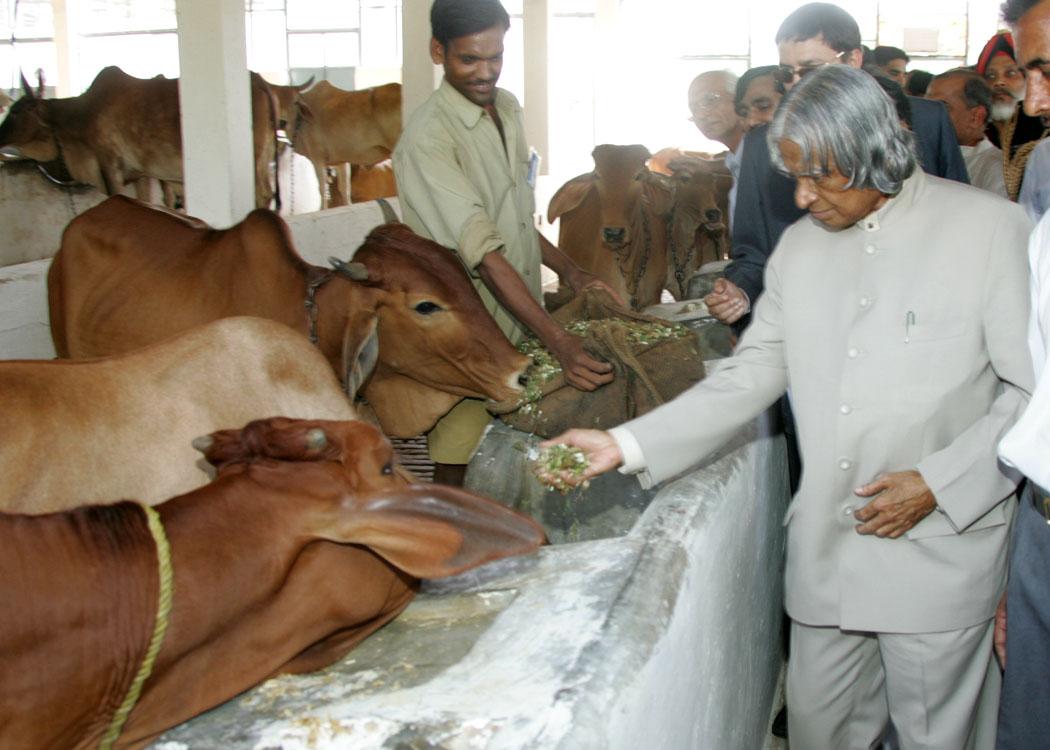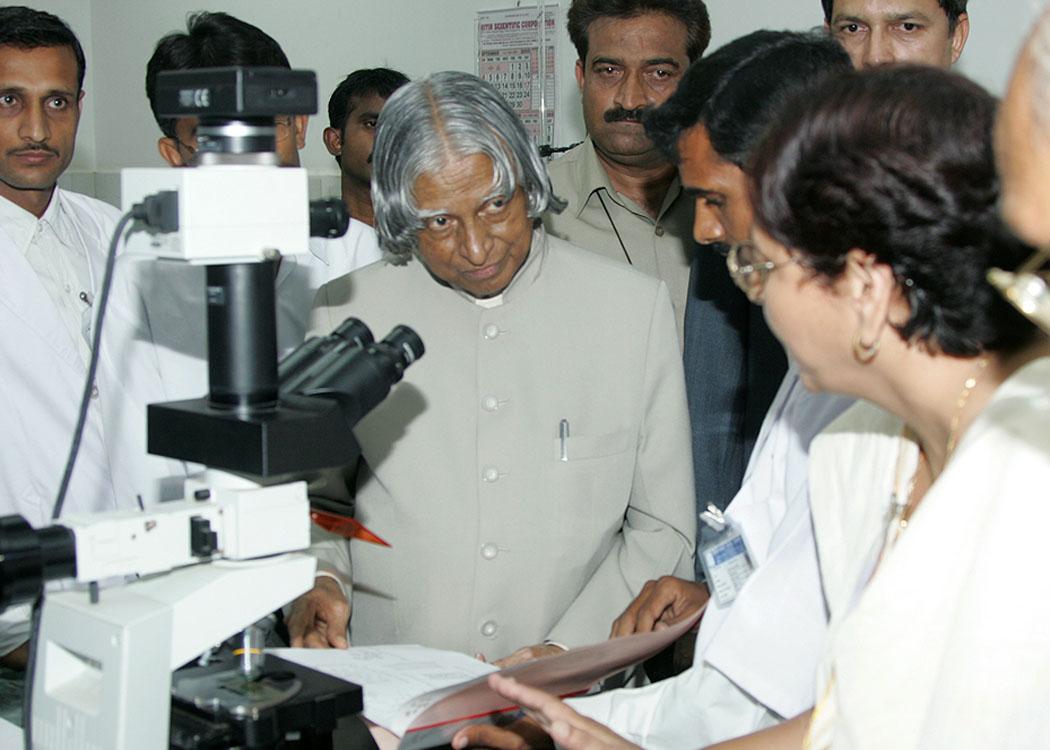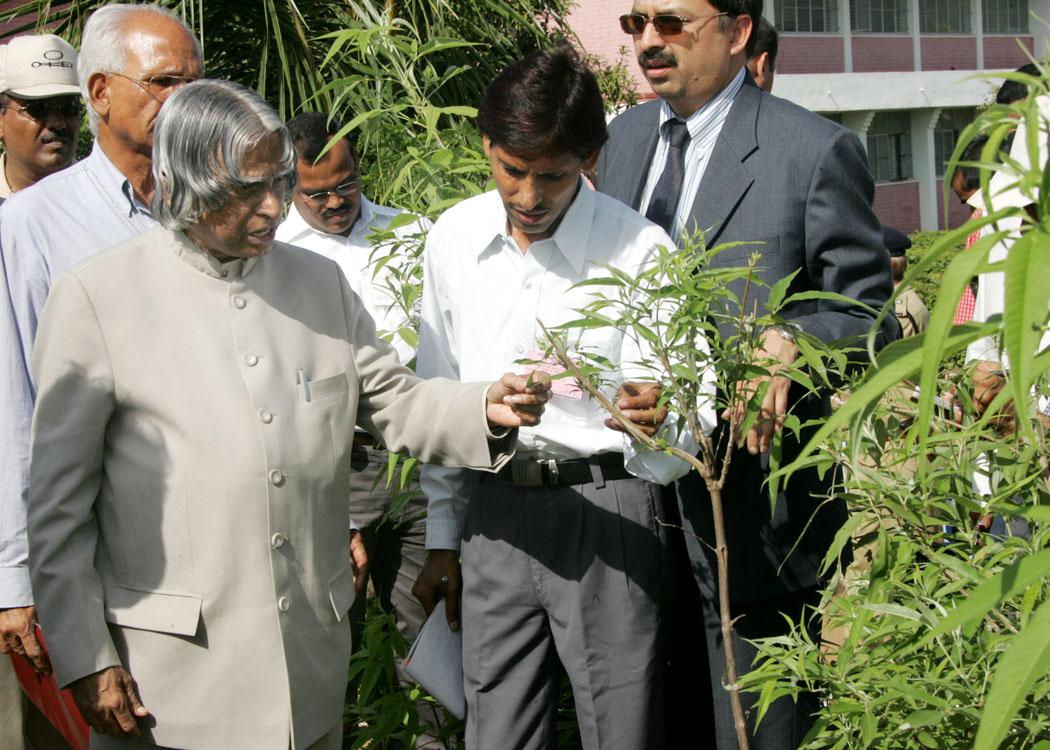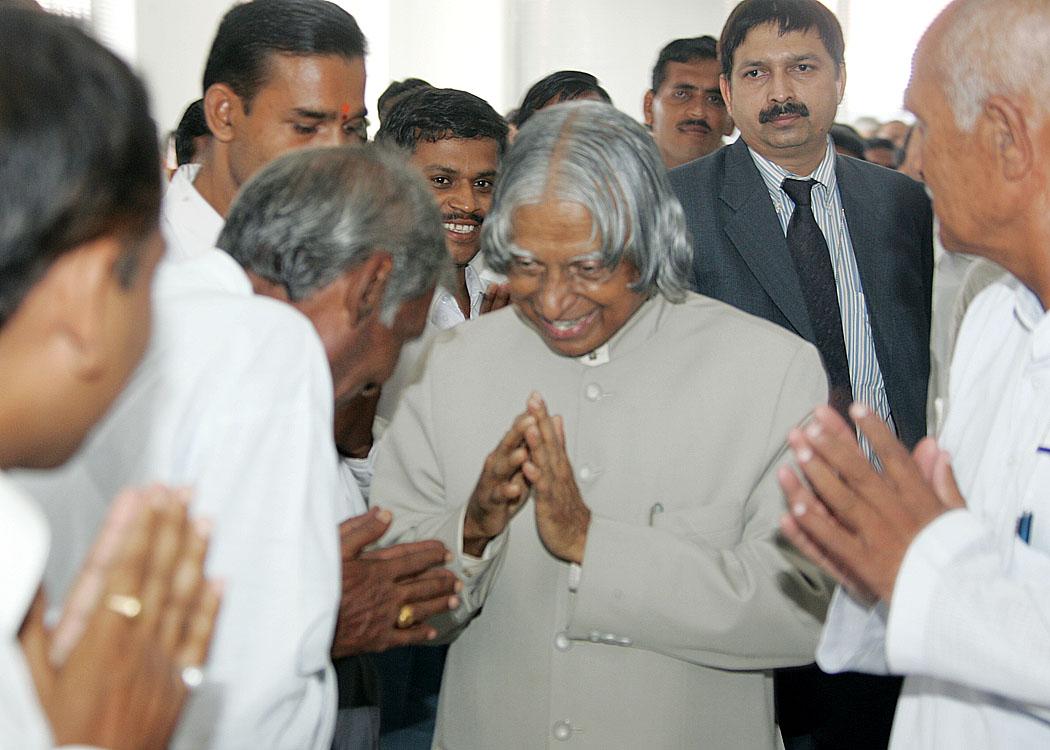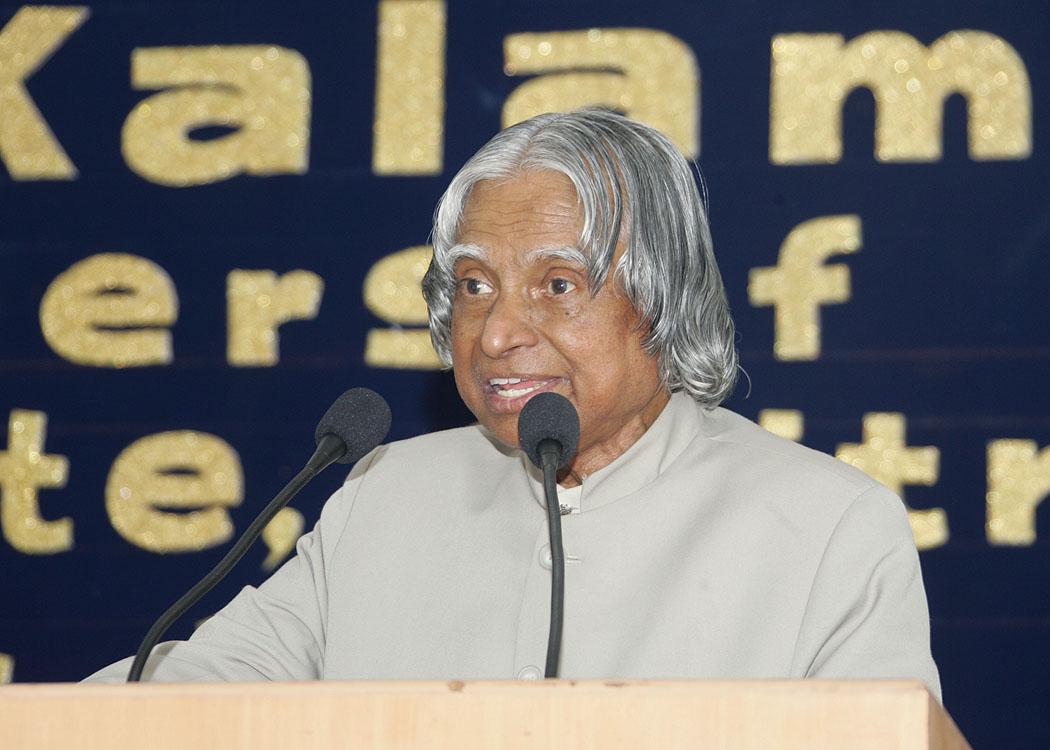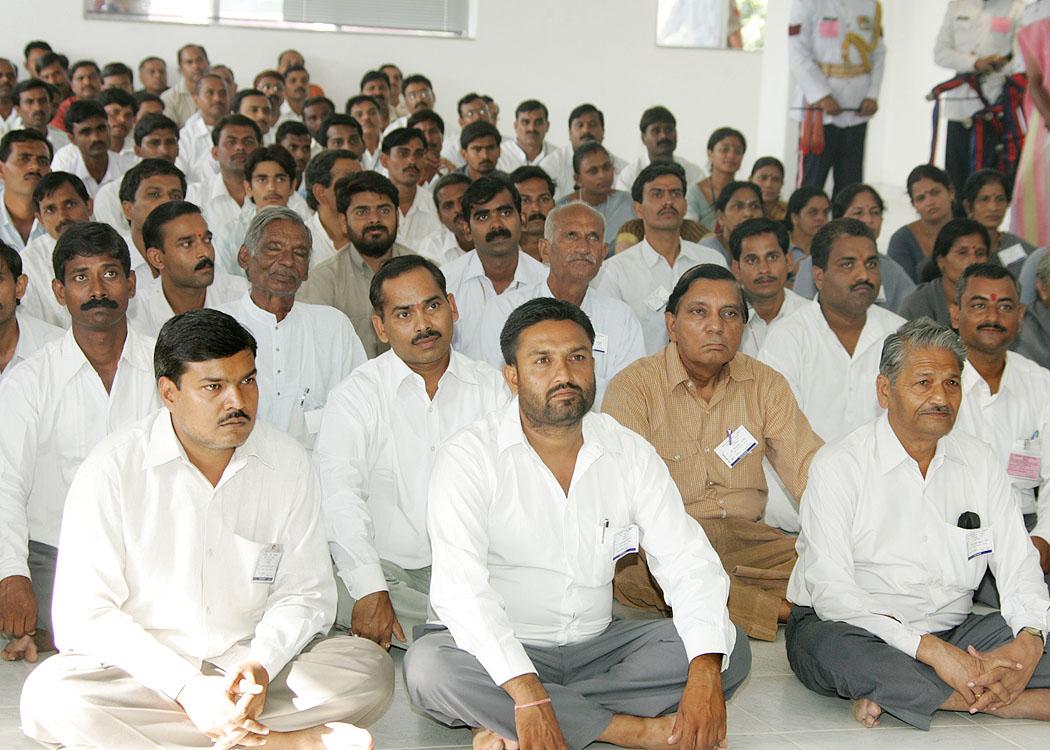Address At The Deendayal Research Institute
Chitrakoot : 06-10-2005
PURA with a Cultural Heritage
I am delighted to be here in Deendayal Research Institute (DRI) located in the beautiful surroundings of Chitrakoot. My greetings to Shri. Nana Deshmukhji, members of the management committee, faculty members and students. DRI is a unique institution developing and implementing a village development model which is most suited for India. Your vast experience is very important for the nation.
DRI understands that people's power is more potent, stable and enduring than political power. By becoming one with the oppressed and depressed, one gains the acumen of administration and governance. Social advancement and prosperity are possible only by injecting the spirit of self-reliance and excellence in the younger generation. Using this principle DRI has plans to develop one hundred clusters of villages having approximately five villages each around Chitrakoot, based on the experience of 80 villages in 16 clusters.
Our National Mission ? Challenges
Our nation is going through a major challenge of uplifting of 260 million people who are below the poverty line. They need habitat, they need food, they need health care, and they need education and employment finally resulting in a good life. Our GDP is growing at more than 7% per annum. Whereas, the economists suggest that to uplift the people below poverty line, our economy has to grow at the rate of 10% per annum consistently, for over a decade.
Integrated Action for Development
To meet the needs of one billion people whose number will further increase, we have a mission of transforming India into a developed nation. We have identified five areas where India has core competencies for integrated action: (1) Agriculture and food processing (2) Reliable and Quality Electric power, Surface transport and Infrastructure for all parts of the country. (3) Education and Healthcare (4) Information and Communication Technology (5) Strategic sectors. These five areas are closely inter-related and when effectively addressed, would lead to food, economic, energy and national security.
Engines for Growth
Emphasis should be on full utilization of natural and human resources of the region to meet the demands of the modern society. We should also remember that about 50% of our population is young people, with aspirations for a better life. Value addition to Agriculture, Manufacturing and Service sectors of the economy, building on the regions? core competencies and technologies, will lead to high income growth rate and employment potential. The engines for growth will be launching of the five national missions viz. water, energy, education and skills, infrastructure and employment generation, which will enable achievement of 10% GDP growth rate per annum, sustainable for a minimum period of ten years.
Participation of educational institutions in Rural Development
For India to be a developed nation, it is essential that there is a massive scheme for development of the rural areas, as 70% of our population lives in villages. Hence the Government has announced the introduction of a scheme called PURA i.e. Providing Urban Amenities in Rural areas. PURA model envisages habitat design to improve the quality of life in rural areas and also removes urban congestion. It is essentially conceived around four types of connectivities with the aim to speed up process of achieving total rural prosperity. Physical connectivity enables high mobility to villagers so that they can interact and use common infrastructure such as school, health centres and markets. The electronic connectivity with telephones and internet facilities bring them together and interact with anyone anywhere in the world. Knowledge connectivity will transform the rural area in education, health care, application of science for crop, water and forest and management, environment protection and cooperative product marketing. The combination of all these three connectivities provides the economic connectivity with small-scale industries, agro and food processing, warehouses, micro power plants, renewable energy farms and banks. The four connectivities will bring prosperity to the villagers and improve quality of life. For our country, around 7000 PURA are planned, for Madhya Pradesh alone will have around 400 PURAs. I would like to talk to you on the two PURAs, apart from Chitrakoot experience.
Periyar PURA
Last year I had visited Periyar Maniammai college of Technology for Women and inaugurated a PURA Complex. I thought of sharing with you the developmental concept of a cluster of over 65 villages near Vallam, Thanjavur district of Tamilnadu which involves a population of 3 lakhs. This PURA complex has all the three connectivities - physical, electronic and knowledge - leading to economic connectivity. The centre of activity emanates from the women engineering college that provides the electronic and knowledge connectivity. I understand that now five of the Periyar PURA villages have been connected with Wi-MAX connectivity. Periyar PURA has health care centres, primary to post graduate level education and vocational training centres. This has resulted in large scale employment generation and creation of a number of entrepreneurs with the active support of 850 self-help groups. Two hundred acres of waste land has been developed into cultivable land with innovative water management schemes such as contour ponds and water sheds for storing and irrigating the fields. All the villagers are busy in cultivation planting Jatropha, herbal and medicinal plants, power generation using bio-mass, food processing and above all running market centres. This model has emanated independent of any government initiative. The committed leadership has been provided by the Engineering institution. This gives me the confidence that PURA is a realizable proposition and this movement can be multiplied by thousands of entrepreneurs, educational administrators and philanthropic institutions with the support of the government agencies.
BAIF model
BAIF (Bharat Agro Industries Foundation, Pune) has organized a tribal rehabilitation programme for sustainable livelihood. The tribal population in Vansda (Navsari district) and Dharampur (Valsad district) blocks of Gujarat were migrating to nearby cities with their families in search of wages as their land holdings were very small and the crop productivity was low. Migration deprived the children of educational and health facilities, while both men and women took to drinking alcohol. These families were motivated to stay back on their own lands and take up cultivation of fruit bearing trees as a measure of generating gainful employment. BAIF provided wages to the families in the formative stages for working on their own lands, as they had no other source of income. They were enabled to grow good quality grafted plants of mango and cashew and also provided with manure and fertilizers. In return, BAIF took a commitment from the families that they would work hard and abstain from alcohol and other addictions.
Simultaneously, the men and women were organized into small Self Help Groups to meet every week and discuss various actions to be initiated under this programme. Watershed development programme was introduced to harvest the rainwater near the fruit gardens (known as Wadi in Gujarat) for providing support irrigation. As sophisticated drip irrigation system was not manageable due to lack of electricity and high cost, pitcher irrigation was promoted. After establishing the fruit trees, the farmers were advised to cultivate various food crops. As the fruit trees started yielding after 3-4 years, other income generation activities such as establishment of fruit nursery, cultivation of vegetables and herbal medicines, sericulture, mushroom production, masonry and carpentry were promoted to generate additional income. Thus, they attained food security right from the first year while the trees started growing and bearing fruits from the third or fourth year, generating a surplus of Rs. 20,000-25,000 per family.
It is the tribal women who were more interested in attending to the field activities and nurturing the orchards. Drudgery reduction and health care were also promoted and the women were able to utilize the time saved for productive work. Today, they have formulated their own cooperatives for processing and marketing of their cashew and mango products and for this advance facility centers have been established for each zone.
This programme has benefited over 50,000 tribal families in Gujarat, Maharashtra, Karnataka and Rajasthan. As the orchard is able to give them substantial income, they have stopped migrating to the cities. These tribals who have established fruit orchards on their degraded lands have not only come out of poverty, but also protected the neighbouring forest area and demonstrated how poverty eradication can be linked with eco-system improvement. Today, this programme has emerged as a unique tribal development model in the country.
BAIF is also engaged in livestock development for promoting animal husbandry on a massive scale covering over 20,000 villages in 9 States. Over the last 35 years, they have helped over 7-8 lakh families to come out of poverty. Under this programme, BAIF provides breeding and advisory services to produce superior quality cattle. A family maintaining 2-3 crossbred cows, earns Rs.18, 000-20,000 per year. This is the result of use of appropriate technologies and ambient management methods.
DRI model
When I look at the activities of DRI, I find that this institute is aiming at a unique economic and social empowerment model for the development of rural areas. The institute is working towards the evolution of sustainable development based on indigenous and traditional technology, knowledge systems and local talents. The research work by the institute through field studies facilitates the development of replicable and tangible model for achieving self-reliance in villages. The programme aims at income generation through value addition, innovative agricultural practices, inculcating scientific temper among the villagers, improvement of health and hygiene, striving towards 100% literacy. Apart from all these development activities the institute is facilitating a cohesive conflict free society. As a result of this, I understand that the eighty villages around Chitrakoot are almost litigation free. The villagers have unanimously decided that no dispute will find its way to court. The differences will be sorted out amicably in the village itself. All these have been accomplished through DRIs ?samaj-shil-pi dampati? a new concept of counseling and intervention promoted by DRI. I congratulate DRI and the people of 80 villages. When I hear this, I am reminded of my childhood experience in Rameshwaram which I would like to share with you.
Dispute resolution through human touch
During 1940?s, every day after the evening namaz, my father used to come back and sit outside (thinnai) our home at Rameshwaram. Each day about 10 to 20 families or at times individuals would come to my father and tell their problems on land and house disputes, marriage conflicts and issues involving forsaking of elderly parents. They will get a solution from my father within two or three days. In a similar way, my mother used to meet many womenfolk on Fridays. They will seek her advice. My elder brother himself was Panchayat Court President. The court had five good human beings from various walks of life and with one State Government representative. In those days, caste system was not visible at all. I used to see many disputes of human life being settled in our own rural environment. Only if the disputes are not settled at these two levels they used to resort to higher courts. After 1970s, all these systems with human touch vanished and most of these disputes are going to courts. I feel, since the Panchayat environment is emerging in rural areas, the judicial system at the Panchayat level also can take a shape with the same type of human touch. Litigation free 80 villages in Chitrakoot is a good example to be followed by many districts. This will substantially reduce the load in our courts.
Conclusion
I see that Chitrakoot project is an integrated model for the development of rural India. It aims at creating a society based on family bonding, pride in Indian culture, modern education wedded to Indian wisdom, easing of social tensions, economic empowerment of all especially the women folk, health for all, cleanliness, concern for environment, equitable distribution of wealth among all the constituent of the society. This concept fully tallies with my view that developed India means not only economic development but also integrated development in art, literature, humanism, nobility in thinking and above all preservation of over five thousand years of our rich cultural heritage.
The per capita income of Chitrakoot villages has to further increase. This is possible only through the three connectivities which I have discussed earlier and the provision of large employment potential with good markets. Rashtrapati Bhavan will be in a position to help DRI in development of Herbal Gardens, Spiritual Gardens, Jatropha Plantation and conversion of products and also electronic and knowledge connectivity.
I congratulate the Shri. Nana Deshmukhji, founder of DRI, and the Deendayal Research Institute for achieving self-reliant sustained development of eighty villages and my best wishes for your next target of realizing the development of total five hundred villages much before 2009.
May God bless you.

